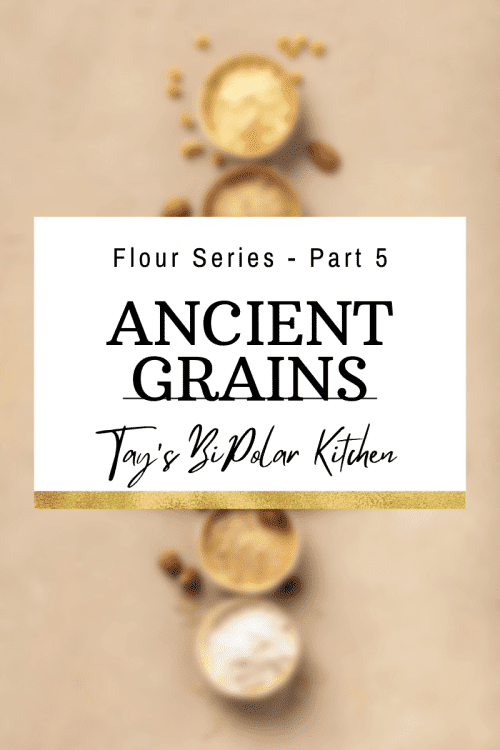Exploring the Nutritional Benefits and Unique Characteristics of Flours Made from Ancient Grains
Welcome to part five of my six-part series on flour. We will dip into common, nut, rice, alternative, and specialty flour. However, right now, we’re talking about flour made from ancient grains!
Whether you’re looking to create wholesome loaves of bread, hearty pasta, or nutritious baked goods, incorporating ancient grain flour into your cooking can add an extra level of richness and depth to your recipes.

If you’re looking to add some diversity to your baking ingredients, consider exploring the world of ancient grain flour. These flours are made from grains that have been around for thousands of years and offer unique flavors, textures, and nutritional benefits compared to more modern varieties. From Einkorn flour to Kamut flour, each ancient grain has unique characteristics and uses in the kitchen.
Amaranth Flour
This type of flour is made from ground amaranth and is a gluten-free alternative to wheat flour. Amaranth flour has a slightly sweet and nutty flavor and is commonly used in gluten-free baked goods, such as cakes, cookies, and breads. It can be used in place of all-purpose flour in some gluten-free recipes, although it will result in a denser and heavier finished product.
Amaranth is an ancient grain that has been cultivated for over 8,000 years and was a staple food of the Aztecs in Mexico. The grain was so valuable to the Aztecs that they even used it as currency and offerings in religious ceremonies. The cultivation of amaranth declined after the arrival of the Spanish conquistadors, who sought to stamp out indigenous religions and foods.
However, amaranth was rediscovered in the 20th century and has since become a popular gluten-free alternative to traditional wheat flours. Today, amaranth flour is used in a variety of baked goods and can be easily found in many health food stores and online.
Buckwheat
Made from the seeds of the buckwheat plant, this flour has a nutty and earthy flavor. It is gluten-free, making it an excellent alternative for people with gluten sensitivities.
Buckwheat flour has a long history, with its origins tracing back to ancient civilizations in Southeast Asia. It was later introduced to Europe and has been used in traditional dishes such as buckwheat pancakes and soba noodles. Today, buckwheat flour is widely used in gluten-free and alternative baking due to its nutty flavor and versatility.
Millet
Next, we have Millet Flour. Millet flour is made from ground millet grain and is gluten-free. It has a slightly sweet, nutty flavor and is high in antioxidants and minerals such as magnesium and potassium. This flour is commonly used in baked goods, porridge, and other dishes.
Millet is one of the oldest cultivated grains, dating back over 5000 years to ancient civilizations in China and Africa. It was a staple food for many cultures, and today it is still used in many traditional dishes, such as porridge and flatbread. Millet flour is gaining popularity in modern times as a gluten-free alternative for its nutritional properties.
Sorghum
Sorghum Flour is another gluten-free option made from ground sorghum grain. It has a mild, sweet flavor and is high in fiber and antioxidants. Sorghum flour is commonly used in baked goods, bread, and other dishes.
Sorghum is another ancient grain with a rich history, originating in Africa and later spreading to other parts of the world. It was used as a staple food and in traditional brewing. Sorghum flour is now gaining recognition as a gluten-free alternative and for its high fiber content.
Teff
Teff Flour is a gluten-free flour made from ground teff grain. It has a slightly nutty, sweet flavor and is high in fiber, protein, and minerals such as iron and calcium. Teff flour is commonly used in injera, a traditional Ethiopian flatbread, as well as in baked goods.
Teff is an ancient grain that has been grown in Ethiopia for thousands of years. It was used as a staple food and in traditional baking, and today it is gaining recognition as a nutritious and gluten-free alternative to traditional flour. Teff flour is also prized for its unique nutty flavor and versatility in baking.
Quinoa Flour
This type of flour is made from ground quinoa and is a gluten-free alternative to wheat flour. Quinoa flour has a nutty flavor and is commonly used in gluten-free baked goods, such as cakes, cookies, and breads. It can be used in place of all-purpose flour in some gluten-free recipes, although it will result in a denser and heavier finished product.
Quinoa flour is made from the ancient grain, quinoa, which is native to South America and was domesticated by the Incas over 5,000 years ago. Quinoa was referred to as the “mother grain” and was a staple in the Inca diet. After the fall of the Inca Empire, quinoa became less popular, but in recent decades, there has been a resurgence of interest in the grain and its flour. The grain was rediscovered in the 1980s and has since been grown in other parts of the world, including North America, Europe, and Australia. Quinoa flour is a gluten-free alternative to wheat flour and is a good source of protein, fiber, and essential vitamins and minerals. It has a light, nutty flavor and can be used in a variety of baked goods, as well as in savory dishes like soups and sauces.
Spelt
Spelt flour is an ancient grain flour that is high in fiber and often used in bread and pastries. High-gluten flour is a high-protein flour commonly used in bread making, while pumpernickel flour is used for making traditional German pumpernickel bread.
Spelt is an ancient type of wheat that has been grown and used for thousands of years. It was a staple grain in ancient civilizations such as the Egyptians and was also a popular grain in medieval Europe. Today, spelt flour is making a comeback as people seek out alternative, whole grain flours that are easy on the digestive system.
Einkorn
Einkorn flour is made from the ancient grain of einkorn wheat, which is considered to be one of the oldest cultivated grains in the world. Einkorn has a lower gluten content than modern wheat, making it easier for some people with gluten sensitivities to digest. Einkorn flour is commonly used in baked goods such as bread, pizza crust, and pastries. It has a sweet, nutty flavor that makes it a great addition to any baking recipe.
Einkorn is one of the oldest known varieties of wheat, and it is thought to have been cultivated for thousands of years. This type of wheat was widely grown in the Near East and the Mediterranean, and it was considered to be a staple food in ancient civilizations such as the Egyptians and the Romans. Einkorn is still grown today, primarily in Europe, and its flour is used to make traditional dishes such as bread, pasta, and baked goods.
Barley
Barley flour is made from ground barley grain. It has a nutty, slightly sweet flavor and is commonly used in baking. Barley flour is high in fiber, vitamins, and minerals, making it a nutritious addition to baked goods. Barley flour is often used in bread, cakes, and cookies but can also be used to make pancakes and waffles.
Barley has been a staple grain for thousands of years, and it was one of the first grains to be domesticated in the Near East. Barley was a staple food in ancient civilizations such as the Egyptians, the Babylonians, and the Romans, and it was also widely used in medieval Europe. Today, barley flour is still used in various baked goods and traditional dishes, and it is also a popular ingredient in health food and whole grain products.
Kamut
Kamut flour is made from the Kamut grain, which is an ancient relative of modern wheat. Kamut flour is high in protein, fiber, and vitamins, making it a nutritious addition to baked goods. Kamut flour has a sweet, nutty flavor and is commonly used in bread, crackers, and pastries.
Kamut is an ancient type of wheat that was first cultivated in the Near East thousands of years ago. This type of wheat was popular in ancient civilizations such as the Egyptians, and it was also widely used in medieval Europe. Kamut was nearly lost to history, but it was rediscovered in the 20th century and is now grown and used as a specialty grain. Kamut flour is prized for its nutty, buttery flavor and its high nutritional content, and it is used in a variety of baked goods and traditional dishes.
In conclusion, these gluten-free and low-carb flours are a great option for those with dietary restrictions and offer a variety of flavors and textures. Give them a try and add some diversity to your baking game!
Let me know if you have tried any of these in your cooking! Use the hashtags #taysbpkitchen and #flourseries
